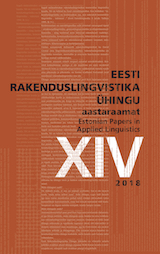Kodaniku suhtlus ametiasutusega teabenõude vahendusel
The communication between the citizen and local authority via the information request
Author(s): Riina ReinsaluSubject(s): Civil Society, Public Administration, Public Law, Pragmatics, Finno-Ugrian studies, Theory of Communication
Published by: Eesti Rakenduslingvistika Ühing (ERÜ)
Keywords: administrative language; textual analysis; genres; e-mail; Estonian Language;
Summary/Abstract: Citizens’ approaches to public offices, with a view to gain certain information, are regulated by the Public Information Act of 2001. According to the law, citizens can put forward their information requests either orally (at the premises or over the phone) or in writing (by mail, fax, email, etc.) and public offices are obligated to respond within five working days. For this dialogical communication to be efficient, both parties must follow well-developed and tacitly accepted communication practices. According to Swales’ (1990) genre theory, the analysis of the inner structure of information requests demonstrates that a prototypical information request consists of six different steps: creating of a communicative situation, justification of the request, putting forward the main request, and if needed, also an additional request, offering additional information and of an ending of the communicative situation. Some differences can be found in the structure of the requests based on whether they were sent in via a web interface or by email. While a part of an information request sent in by email is also to end the particular communicative situation (email usually ends with polite wishes and sender’s name) then in information requests sent by web interfaces senders often limit themselves to only voicing their main request. The requests in the information requests analysed in this study are formulated mainly as pleas. The please-construction in the request helps to build a short and speedy information exchange and it also contributes towards decreasing the nature or tone of the request. For example, it allows one to use the imperative mood or to change a direct question into an indirect one. In addition to the pleading acts, Estonian information requests also contain wishing and asking acts whereas other ways of expressing the request (verbless constructions, order, expectation, hope and need) are represented only by a few cases in our analysed source material. The inner structure of information requests, and the way they are being expressed, forms interpersonal relations between the parties and offers possibilities for demonstrating one’s power. Since citizens usually limit themselves to the main information request without using any softening moves or giving any special attention to the communicative situation, the sender of the request puts oneself to a clear power position. The power relations are somewhat balanced by the way the request is being put forward for the request is being served as a plea or wish to officials. Officials’ replies do not, however, depend on whether the request was put in direct or indirect manner because they are obligated under the law to reply no matter what.
Journal: Eesti Rakenduslingvistika Ühingu aastaraamat
- Issue Year: 2018
- Issue No: 14
- Page Range: 171-183
- Page Count: 13
- Language: Estonian

